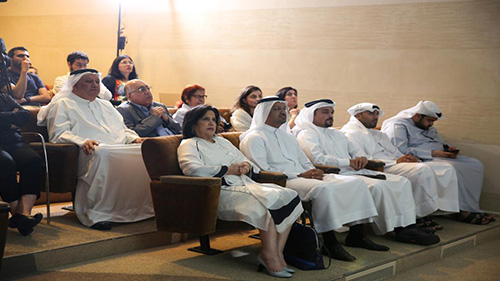06 November 2019
Lecture by Dr. Nader Kadhim on the History of Manama City , At Bahrain National Museum Lecture Hall


Bahrain National Museum Lecture Hall hosted, on 6 November 2019, a lecture titled “Manama… A biography of a Place and its People”, by Dr. Nader Kadhem, Bahraini critic and writer, in the presence of H.E Shaikha Mai bint Mohammad Al Khalifa, President of Bahrain Authority for Culture and Antiquities (BACA), an interactive huge audience and enthusiasts about Bahrain’s history and heritage.
Dr. Nader Kadhem, expressed his thanks and gratitude to H.E Shaikha Mai Bint Mohammad Al-Khalifa for relentless efforts to enhance the cultural scene in Bahrain. Dr Nader also lauded her keenness to achieve a new revival and restoration of the historical city of Manama, a genuine cultural and urban destination, affirming that the importance of Manama and Muharraq cities as the key symbols to understand the history of modern Bahrain.
Dr. Nader Kadhem argued that it is crucial important to regain the historical genuine identity of the Manama city through an awareness campaign about the place, its future within the official development plan. Dr. Kadhem added to say that the Manama is not simply the capital of the Kingdom of Bahrain and its first economic destination, but rather as the citadel of its modern history, given that the first municipal government was established in Manama in 1920s, the customs office was reorganized in 1920s too, other departments, such as Health services, police, electricity and other civil agencies were all centered in this city. Manama city was also the central stage for all political developments after the independence and its aftermath, the economic, cultural and social metamorphose in Bahrain, Dr. Nader added.
Dr. Nader Kadhem also revealed that Manama city has gone through four major transformations and developments in its history; the first happened in the late 18th century and the beginning of the 19th century when the city changed its character from a small village to a prosperous commercial city where foreign delegations can settle and thrive. The lecturer has demonstrated that this transformation was due to the British policy aimed at that time to connect all its previous protectorates, from east to West, after the Industrial Revolution in the main land, and in Europe, in general. This had contributed to a boom in trade routes, lifestyle, increased demand for the best natural pearl gems, the pride of Bahrain. Thus, pearl diving and trade in Bahrain wasn’t simply the result of small-scale exploration but mainly of an organized bureaucracy that towards the end of the 19th century merged colonial intervention and a centralized government that abolished tribal feudal states giving rise to a series of reforms that unavoidably opened Bahrain and in particular Manama to the rest of the world.
The second biggest transformation of the city of Manama, according to Dr. Nader, happened in the beginning of the 20th century, due to the discovery of petroleum on Bahrain (1932), which revolutionized the city’s economy and appearance, with the construction of many modern buildings. Manama developed as a trade, financial, and commercial centre; it is the seat of numerous banks. The Third development of the city was in the beginning of the 1960s, transforming Manama from an old historical city, into a poor and overpopulated by foreign migrant economic workers because of the end of Manama’s port exploitation and the inauguration of new Mina Salman Port and King Fahad Causeway. The reason behind this late transformation was that the maritime and commercial movement activities, which were behind the city’s prosperous economy, stopped, giving rise to huge unemployment wave. At the same time, the oil discovery and boom gave way to new wave of foreign immigrant workers flocking into the country and the city of Manama to help the implementation of many new urban and economic projects.
Dr. Nader Kadhem noted that The fourth and last transformation changed Manama into major tourism and real estate development projects and investments. New plans to develop the city and the need to restore and safeguard its historical buildings, have given rise to huge economic development projects, such as the Financial Harbour, Reef Island in the heart of Manama, and other mega urban plans.
Dr. Nader Kadhem argued also that a series of reforms implemented already since the 1920s gave the city a more or less coherent form that nevertheless did not translate into organic growth. A master plan had been concocted since the 1940s, officially approved in 1968 but only implemented after independence in 1971, with more or less mixed results. The most significant urban modernization project that took place in Manama was the famous Bab Al Bahrain, part of the renewal of the waterfront implemented through land reclamation. The project was designed in 1945 as the seat of government which created a city center in accordance with modern regulations and featured modernist architecture into some indigenous features. The urban transformation of Manama into high rises and the internal displacement into suburbs of the native population has caused the square to turn into a series of parking lots, while still retaining historical and geographical importance, being located at the very entrance of the Manama souks.
The lecturer also highlighted the demographical realities of the Manama and its immigrant foreign population number’s rise from 1889 until 2018, showcasing a number of the city’s maps dating back to the 19th century & 20th century. Dr. Nader Kadhem also presented a series of photos depicting the major landmarks of Manama and its urban developments.







